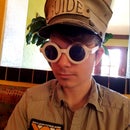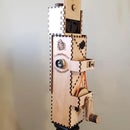Introduction: Develop Film and Photopaper With Household Chemicals
Developing black and white film is fun and pretty easily accomplished at home. There's a solution called caffenol that's made from easily found household chemicals. That would give you negatives, just like the ones you get from the one hour photo you visit when you time-travel to the 1990s. Watch out for stray mullets.
Now, there are photography snobs that will tell you making your own developer is a garbage idea. I LOVE garbage ideas. So let's get started with your supplies.
Step 1: Supplies for Developing Film Into Negatives
Developing Bath Directions
Mix the washing soda with 1 liter of water. Mix the coffee crystals with your other 1 liter of water. Mix vitamin C with coffee mix. Mix both liters together. You've got yourself some developer now!
-80 grams Instant coffee
-108 grams Washing Soda
(this is NOT baking soda but if you only have baking soda, you can add the extra carbon atoms to make it into washing soda by putting a 2mm layer of baking soda on a baking pan and baking it until it no longer behaves as a powder but flakes apart more like sand, usually 400 degrees for an hour.)
-32 grams Vitamin C Powder
-2 liters of water
Fixer Bath Directions
You can just buy fixer online. Messing around with making your own is very irritating. Ilford's Rapid Fixer is 1+4 solution. So say you want 2 liters. You mix 400ml concentrate with 1600ml water. Just like mother use to make.
But...Homemade Fixer
Okay, you really REALLY want to make your own? Fine. Mix as much salt as will dissolve in 2 liters of warm water. It's A LOT. Your film sits in that at room temperature for 24 hrs or MORE and may or may not be archival fixed. Have fun with that. Come on, buy the fixer.
Step 2: Make a Dark Room and Develop Stuff!
Introductions
Fun things happen in the dark. If it isn't completely dark, you get disappointed pretty quick. Hitting too close to home for anyone?
Okay, I use my bathroom as a dark room. There's no shame in it. Just block out the poorly planned window across from your shower and seal up any light leaks coming from door. And tell your roommate you need 'me time.' Laugh maniacally every 5 or so minutes. And don't explain the horrible smell of caffenol. Seriously, it stinks.
You can use this process for film or photo paper. If you are using photo paper, you need to rinse VERY thoroughly after developing because the fibers absorb the chemicals. Developing times vary so have fun with the process and take notes! Only change 1 variable at a time, kids.
Step 1
You're going to take out your film in complete darkness and load into your developing tank. I have an old reel-to-reel developing tank but many people use Paterson Developing Tanks or knock-offs thereof. The neat thing about actually having a developing tank is you don't need to be in complete darkness for the whole process. That means the shadow creatures won't have time to crawl from the corners and get you JUST before you finish processing your film.
Okay so you want to use a bucket. OK.
Step 2
After film is loaded, pre-wash film. This gets the film in the mood to be processed. Actually, it helps prevent splotching. Just cover the film in water, agitate a bit and empty the water.
Step 3
You're going to pour your developer into your tank now. Go ahead and poor and agitate your film. Instructions vary here depending on your equipment but if you're using a bucket with a lid, shake it every 30 seconds for 5 or so seconds. We want fresh developer on the film as often as possible. How long do you keep this up? Well, between 8 and 15 minutes. You'll have to experiment here. I do it for 15 minutes but my equipment is slow to expose all film to develop.
Step 4
Your film has been in the developer for 15 minutes. Pour developer back in its storage container. Rinse your film thoroughly with water twice.
Step 5
Now, pour in your fixer. The store bought one. 5 minutes agitating every 30 seconds should be fine.
Step 6
Lights on. Rinse with water twice, agitating. Add a drop of detergent and keep rinsing.
Step 7
Hang to dry.
Step 3: Conclusion
Have fun with the process. There's lots of neat products out there, like photo paper that produces direct positives! Experiment with pinhole cameras. That's a lot of fun. If you're feeling ambitious, try your hand at making your own hand-cranked motion picture camera from scratch! I have an instructable on that!
You can see my results here and in my motion picture instructable. My results are not always perfect and yours won't be either. But with time, you'll get some awesome things that are truly memorable and fun to share!
I'll be here after class to answer questions. Class dismissed!













